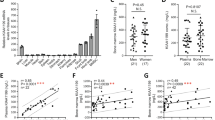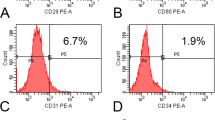Abstract
Adult stem cells have therapeutic potential because of their intrinsic capacity for self-renewal, especially for bone regeneration. The present study shows the utility of ex vivo modified mesenchymal stem cells (MSC) to enhance bone density in an immunocompetent mouse model of osteopenia. MSC were transduced ex vivo with a recombinant adeno-associated virus 2 (rAAV2) expressing bone morphogenetic protein 2 (BMP2) under the transcriptional control of collagen type-1α promoter. To enrich bone homing in vivo, we further modified the cells to transiently express the mouse α4 integrin. The modified MSC were systemically administered to ovariectomized, female C57BL/6 mice. Effects of the therapy were determined by dual-energy X-ray absorptiometry, 3D micro-CT, histology and immunohistochemistry for up to 6 months. Results indicated that mice transplanted with MSC expressing BMP2 showed significant increase in bone mineral density and bone mineral content (P<0.001) with relatively better proliferative capabilities of bone marrow stromal cells and higher osteocompetent pool of cells compared to control animals. Micro-CT analysis of femora and other bone histomorphometric analyses indicated more trabecular bone following MSC-BMP2 therapy. Results obtained by transplanting genetically modified MSC from green fluorescent protein transgenic mouse suggested that production of BMP2 from transplanted MSC also influenced the mobilization of endogenous progenitors for new bone formation.
This is a preview of subscription content, access via your institution
Access options
Subscribe to this journal
Receive 12 print issues and online access
$259.00 per year
only $21.58 per issue
Buy this article
- Purchase on Springer Link
- Instant access to full article PDF
Prices may be subject to local taxes which are calculated during checkout






Similar content being viewed by others
References
Bi Y, Ehirchiou D, Kilts TM, Inkson CA, Embree MC, Sonoyama W et al. Identification of tendon stem/progenitor cells and the role of the extracellular matrix in their niche. Nat Med 2007; 13: 1219–1227.
Urbán VS, Kiss J, Kovács J, Gócza E, Vas V, Monostori E et al. Mesenchymal stem cells cooperate with bone marrow cells in therapy of diabetes. Stem Cells 2008; 26: 244–253.
Zhang X, Zhang C, Tang T, Qu Z, Lou J, Dai K . Immunomodulatory and osteogenic differentiation effects of mesenchymal stem cells by adenovirus-mediated coexpression of CTLA4Ig and BMP2. J Orthop Res 2008; 26: 314–321.
Nixon AJ, Goodrich LR, Scimeca MS, Witte TH, Schnabel LV, Watts AE et al. Gene therapy in musculoskeletal repair. Ann NY Acad Sci 2007; 1117: 310–327.
Horwitz EM, Gordon PL, Koo WK, Marx JC, Neel MD, McNall RY et al. Isolated allogeneic bone marrow-derived mesenchymal cells engraft and stimulate growth in children with osteogenesis imperfecta: implications for cell therapy of bone. Proc Natl Acad Sci USA 2002; 99: 8932–8937.
Swieszkowski W, Tuan BH, Kurzydlowski KJ, Hutmacher DW . Repair and regeneration of osteochondral defects in the articular joints. Biomol Eng 2007; 24: 489–495.
Kumar S, Chanda D, Ponnazhagan S . Therapeutic potential of genetically modified mesenchymal stem cells. Gene Therapy 2008; 15: 711–715.
Takahashi T, Kalka C, Masuda H, Chen D, Silver M, Kearney M et al. Ischemia- and cytokine-induced mobilization of bone marrow-derived endothelial progenitor cells for neovascularization. Nat Med 1999; 5: 434–438.
Kurozumi K, Nakamura K, Tamiya T, Kawano Y, Ishii K, Kobune M et al. Mesenchymal stem cells that produce neurotrophic factors reduce ischemic damage in the rat middle cerebral artery occlusion model. Mol Ther 2005; 11: 96–104.
Kanehira M, Xin H, Hoshino K, Maemondo M, Mizuguchi H, Hayakawa T et al. Targeted delivery of NK4 to multiple lung tumors by bone marrow-derived mesenchymal stem cells. Cancer Gene Ther 2007; 14: 894–903.
Hamada H, Kobune M, Nakamura K, Kawano Y, Kato K, Honmou O et al. Mesenchymal stem cells (MSC) as therapeutic cytoreagents for gene therapy. Cancer Sci 2005; 96: 149–156.
Kan I, Melamed E, Offen D . Integral therapeutic potential of bone marrow mesenchymal stem cells. Curr Drug Targets 2005; 6: 31–41.
Kumar S, Mahendra G, Nagy TR, Ponnazhagan S . Osteogenic differentiation of recombinant adeno-associated virus 2-transduced murine mesenchymal stem cells and development of an immunocompetent mouse model for ex vivo osteoporosis gene therapy. Hum Gene Ther 2004; 15: 1197–1206.
Kumar S, Mahendra G, Ponnazhagan S . Determination of osteoprogenitor-specific promoter activity in mouse mesenchymal stem cells by recombinant adeno-associated virus transduction. Biochim Biophys Acta 2005; 1731: 95–103.
Iemura S, Yamamoto TS, Takagi C, Kobayashi H, Ueno N . Isolation and characterization of bone morphogenetic protein-binding proteins from the early Xenopus embryo. J Biol Chem 1999; 274: 26843–26849.
Zuniga A, Haramis AP, McMahon AP, Zeller R . Signal relay by BMP antagonism controls the SHH/FGF4 feedback loop in vertebrate limb buds. Nature 1999; 401: 598–602.
Macias D, Gañan Y, Sampath TK, Piedra ME, Ros MA, Hurle JM . Role of BMP-2 and OP-1 (BMP-7) in programmed cell death and skeletogenesis during chick limb development. Development 1997; 124: 1109–1117.
Hashimoto K, Yokouchi Y, Yamamoto M, Kuroiwa A . Distinct signaling molecules control Hoxa-11 and Hoxa-13 expression in the muscle precursor and mesenchyme of the chick limb bud. Development 1999; 126: 2771–2783.
Palcy S, Bolivar I, Goltzman D . Role of activator protein 1 transcriptional activity in the regulation of gene expression by transforming growth factor beta1 and bone morphogenetic protein 2 in ROS 17/2.8 osteoblast-like cells. J Bone Miner Res 2000; 15: 2352–2361.
Harada H, Tagashira S, Fujiwara M, Ogawa S, Katsumata T, Yamaguchi A et al. Cbfa1 isoforms exert functional differences in osteoblast differentiation. J Biol Chem 1999; 274: 6972–6978.
Ogata T, Wozney JM, Benezra R, Noda M . Bone morphogenetic protein 2 transiently enhances expression of a gene, Id (inhibitor of differentiation), encoding a helix-loop-helix molecule in osteoblast-like cells. Proc Natl Acad Sci USA 1993; 90: 9219–9222.
Enomoto-Iwamoto M, Nakamura T, Aikawa T, Higuchi Y, Yuasa T, Yamaguchi A et al. Hedgehog proteins stimulate chondrogenic cell differentiation and cartilage formation. J Bone Miner Res 2000; 15: 1659–1668.
Franceschi RT, Wang D, Krebsbach PH, Rutherford RB . Gene therapy for bone formation: in vitro and in vivo osteogenic activity of an adenovirus expressing BMP7. J Cell Biochem 2000; 78: 476–486.
Hollnagel A, Ahrens M, Gross G . Parathyroid hormone enhances early and suppresses late stages of osteogenic and chondrogenic development in a BMP-dependent mesenchymal differentiation system (C3H10T1/2). J Bone Miner Res 1997; 12: 1993–2004.
Gitelman SE, Kobrin MS, Ye JQ, Lopez AR, Lee A, Derynck R . Recombinant Vgr-1/BMP-6-expressing tumors induce fibrosis and endochondral bone formation in vivo. J Cell Biol 1994; 126: 1595–1609.
Jikko A, Harris SE, Chen D, Mendrick DL, Demsky CH . Collagen integrin receptors regulate early osteoblast differentiation induced by BMP-2. J Bone Miner Res 1999; 14: 1075–1083.
Xiao G, Gopalakrishnan R, Jiang D, Reith E, Benson MD, Franceschi RT . Bone morphogenetic proteins, extracellular matrix, and mitogen-activated protein kinase signaling pathways are required for osteoblast-specific gene expression and differentiation in MC3T3-E1 cells. J Bone Miner Res 2002; 17: 101–110.
Kumar S, Ponnazhagan S . Bone homing of mesenchymal stem cells by ectopic {alpha}4 integrin expression. FASEB J 2007; 21: 3917–3927.
Phinney DG, Prockop DJ . Concise review: mesenchymal stem/multi-potent stromal cells (MSCs): the state of transdifferentiation and modes of tissue repair—current views. Stem Cells 2007; 25: 2896–2902.
Krause DS, Theise ND, Collector MI, Henegariu O, Hwang S, Gardner R et al. Multi-organ, multi-lineage engraftment by a single bone marrow-derived stem cell. Cell 2001; 105: 369–377.
Horwitz EM, Prockop DJ, Gordon PL, Koo WW, Fitzpatrick LA, Neel MD et al. Clinical responses to bone marrow transplantation in children with severe osteogenesis imperfecta. Blood 2001; 97: 1227–1231.
Sobajima S, Vadala G, Shimer A, Kim JS, Gilbertson LG, Kang JD . Feasibility of a stem cell therapy for intervertebral disc degeneration. Spine J 2008; 8: 888–896.
Falanga V, Iwamoto S, Chartier M, Yufit T, Butmarc J, Kouttab N et al. Autologous bone marrow-derived cultured mesenchymal stem cells delivered in a fibrin spray accelerate healing in murine and human cutaneous wounds. Tissue Eng 2007; 13: 1299–1312.
Caplan AI, Dennis JE . Mesenchymal stem cells as trophic mediators. J Cell Biochem 2006; 98: 1076–1084.
Tu Q, Valverde P, Li S, Zhang J, Yang P, Chen J . Osterix overexpression in mesenchymal stem cells stimulates healing of critical-sized defects in murine calvarial bone. Tissue Eng 2007; 13: 2431–2440.
Gao J, Dennis JE, Muzic RF, Lundberg M, Caplan AI . The dynamic in vivo distribution of bone marrow-derived mesenchymal stem cells after infusion. Cells Tissues Organs 2001; 169: 12–20.
Jin H, Aiyer A, Su J, Borgstrom P, Stupack D, Friedlander M et al. Homing mechanism for bone marrow-derived progenitor cell recruitment to the neovasculature. J Clin Invest 2006; 116: 652–662.
Schadendorf D, Gawlik C, Haney U, Ostmeier H, Suter L, Czarnetzki BM . Tumour progression and metastatic behaviour in vivo correlates with integrin expression on melanocytic tumours. J Pathol 1993; 170: 429–434.
Stender S, Murphy M, O’Brien T, Stengaard C, Ulrich-Vinther M, Søballe K et al. Adeno-associated viral vector transduction of human mesenchymal stem cells. Eur Cell Mater 2007; 13: 93–99.
Askari AT, Unzek S, Popovic ZB, Goldman CK, Forudi F, Kiedrowski M et al. Effect of stromal-cell-derived factor 1 on stem-cell homing and tissue regeneration in ischaemic cardiomyopathy. Lancet 2003; 362: 697–703.
Lee JY, Qu-Petersen Z, Cao B, Kimura S, Jankowski R, Cummins J et al. Clonal isolation of muscle-derived cells capable of enhancing muscle regeneration and bone healing. J Cell Biol 2000; 150: 1085–1100.
Haynesworth SE, Baber MA, Caplan AI . Cytokine expression by human marrow derived mesenchymal progenitor cells in vitro: effects of dexamethasone and IL-1 alpha. J Cell Physiol 1996; 166: 585–592.
Keilhoff G, Stang F, Goihl A, Wolf G, Fansa H . Transdifferentiated mesenchymal stem cells as alternative therapy in supporting nerve regeneration and myelination. Cell Mol Neurobiol 2006; 26: 1233–1250.
Kalajzic I, Kalajzic Z, Kaliterna M, Gronowicz G, Clark SH, Lichtler AC et al. Use of type I collagen green fluorescent protein transgenes to identify subpopulations of cells at different stages of the osteoblast lineage. J Bone Miner Res 2002; 17: 15–25.
Bauss F, Dempster DW . Effects of ibandronate on bone quality: preclinical studies. Bone 2007; 40: 265–273.
Marie PJ . Strontium ranelate: a dual mode of action rebalancing bone turnover in favour of bone formation. Curr Opin Rheumatol 2006; 18: S11–S15.
Wahl DA, Czernuszka JT . Collagen-hydroxyapatite composites for hard tissue repair. Eur Cell Mater 2006; 11: 43–56.
Ren C, Kumar S, Shaw DR, Ponnazhagan S . Genomic stability of self-complementary adeno-associated virus 2 during early stages of transduction in mouse muscle in vivo. Hum Gene Ther 2005; 16: 1047–1057.
Kalajzcic I, Kalajzcic J, Hurley M, Licthler A, Rowe D . Stage specific inhibition of osteoblast lineage differentiation by FGF2 and Noggin. J Cell Biochem 2003; 88: 1168–1176.
Acknowledgements
Financial support of the National Institutes of Health Grants AR50251, CA133737 and the US Army Department of Defense Grants BC044440 and PC050949 are gratefully acknowledged.
Author information
Authors and Affiliations
Corresponding author
Additional information
Supplementary Information accompanies the paper on Gene Therapy website (http://www.nature.com/gt)
Rights and permissions
About this article
Cite this article
Kumar, S., Nagy, T. & Ponnazhagan, S. Therapeutic potential of genetically modified adult stem cells for osteopenia. Gene Ther 17, 105–116 (2010). https://doi.org/10.1038/gt.2009.116
Received:
Revised:
Accepted:
Published:
Issue Date:
DOI: https://doi.org/10.1038/gt.2009.116
Keywords
This article is cited by
-
Systemic therapy of MSCs in bone regeneration: a systematic review and meta-analysis
Stem Cell Research & Therapy (2021)
-
Improved therapeutic potential of MSCs by genetic modification
Gene Therapy (2018)
-
BMP2 gene delivery to bone mesenchymal stem cell by chitosan-g-PEI nonviral vector
Nanoscale Research Letters (2015)
-
Gene therapy in India: A focus
Journal of Biosciences (2014)



